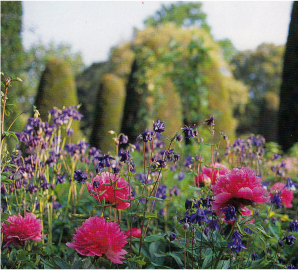
One of England’s most famous gardens, Hidcote could be described as organized confusion. At first, the many exterior garden “rooms” seem to be unrelated to each other, each with its own theme and color and planting schemes. We’d pass through an arch cut into a yew hedge or through a wrought iron gate and say to ourselves, Ah, this must be the Fuchsia Garden or the Poppy Garden or the Long Walk. Wait a minute, is this the Alpine Garden or…? Although, we preferred some of these enclosed gardens to others and some had yet to reach their seasonal peak, we found something to admire in each of them.
Gradually, we came to understand that these different growing spaces were designed to slowly unfold, “revealing,” as their creator, Lawrence Johnston, said, “a different atmosphere or new vista at every turn.” In the words of today, we just had to go with the flow. Exploring was part of the pleasure. This was quire a different experience than in the other gardens we’d been visiting on this trip--gardens that seemed to hang together in a much more logical way. Since we couldn’t see from one “room” to the other, we couldn’t see at a glance how they related to each other. Or if they even did.
Some of the gardens reflected Johnston’s time in Italy and France, rather formal and structured, but others suggested a more casual traditional English approach, with their lush, abundant plantings and borders blending together like flowers woven on a tapestry. We picked up a number of different gardening ideas from the gardens at Hidcote, but they didn’t necessarily relate to each other. We’ll have to discover later if they will even work in our smaller Berkeley garden.
Bruce Douglas Reeves,
author, DELPHINE, winner
of the Clay Reynolds Novella Contest
 RSS Feed
RSS Feed